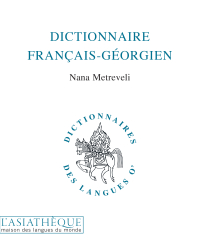Details
Format: Paperback
ISBN: 9782915255300
Collection: Hors Collection
12.6 x 17.4 cm
Weight: 303 gr
Pages: 320
First publication: 16/03/2006
Last printing: 05-2023
Precis pratique de grammaire grecque moderne
With this practical handbook, French speakers have at hand a quick reference to solve problems they may encounter in modern Greek grammar. Specifically designed for a French-speaking audience, this handy reference book develops in detail grammatical points which are often ignored in books designed for a Greek-speaking audience or a generalized foreign public. Here, the reader can find rules for orienting oneself around the "principle accent", learning the necessary and habitual word order, and choosing between abbreviated or continuous verbal forms. There are also translations of various Gallicisms. Tables giving the most important informations are grouped at the end of the book for easy reference. The book also contains a glossary of grammatical terms and an index of commonly studied Greek words. In the style of past Greek grammar books, the handbook also includes a list of rules to memorize, with accompanying examples.
CONTRIBUTORS' BIOGRAPHIES
Henri Tonnet
Henri Tonnet, professor emeritus at the Sorbonne, headed the study center Balkan Studies of Inalco and the Neo-Hellenic Institute of the Sorbonne. Creator, with Guy Saunier, of the Revue des études néo-helleniques, he was editor in chief of the Cahiers balkaniques.
TABLE OF CONTENTS
Introduction
1. ÉCRITURE (1. WRITING)
2. PHONÉTIQUE (2. PHONETICS)
Généralités (Generalities)
2.1 Les conditions de la sonorisation des consonnes sourdes (2.1 Conditions for the voicing of deaf consonants)
2.1.1 Occlusives et spirantes. Sourdes et sonores (2.1.1 Occlusives and spirals. Deaf and sonorous)
2.1.2 Une sonorisation inexistante en grec (2.1.2 A non-existent sound system in Greek)
2.1.3 Sonorisation automatique dans le mot et le « syntagme » ( 2.1.3 Automatic sounding in the word and the "syntagm")
2.1.3.1 Précision indispensable à propos du « syntagme » (2.1.3.1 Important clarification about the "syntagm")
2.1.3.2 Exemples (2.1.3.2 Examples)
2.2 Simplification des géminées pouvant se créer dans le « syntagme(2.2 Simplification of the geminates that can be created in the "syntagm")
2.3 Maintien ou chute du v final dans les proclitiques (articles, pronoms personnels faibles, négations) (2.3 Maintaining or dropping the final v in proclitics (articles, weak personal pronouns, negations))
2.3.1 Deux mots de phonétique historique (2.3.1 Two words of historical phonetics)
2.3.2 Règle (2.3.2 Rule)
2.3.3 Exceptions (2.3.3 Exceptions)
2.3.4 Phonétique et orthographe (2.3.4 Phonetics and spelling)
2.4 Les élisions (2.4 Elisions)
2.4.1 Voyelles en hiatus (2.4.1 Vowels in hiatus)
2.4.2 Voyelles devenant consonne (2.4.2 Vowels becoming consonant)
3. ACCENTUATION
3.1 Des trois sortes d'accents prononcés et/ou notés (3.1 The three kinds of pronounced and/or notated accents)
3.1.1 Monosyllabes et dissyllabes atones et accentués (3.1.1 Atonic and accented monosyllables and dissyllables)
3.1.2 Monosyllabes accentués à l' écrit (3.1.2 Accented monosyllables in written form)
3.1.3 Dissyltabes apparents atones (3.1.3 Apparent atonic dissyltabes)
3.2 Écriture de l'accent (3.2 Writing of the accent)
3.3 Généralités sur l'accent de mot ou de « syntagme » (3.3 General information on word or "phrase" stress)
3.4 L'accent et la limite du mot et du « syntagme », Loi de limitation syllabique (3.4 The accent and the limit of the word and the "syntagm", Law of syllabic limitation)
3.5 Modifications de l'accentuation en fonction du nombre de syllabes de la finale (3.5 Changes in stress according to the number of syllables in the final)
3.5.1 Cas du mot proprement dit (3.5.1 Case of the word itself)
3.5.2 Cas du « syntagme » avec enclitique (3.5.2 Case of the "syntagm" with enclitic)
3.6 Modifications de l'accentuation en fonction des anciennes quantités des voyelles finales (3.6 Modifications of the accentuation according to the old quantities of the final vowels)
3.6.1 Anciennes quantités des voyelles finales (3.6.1 Former quantities of final vowels)
3.6.2 Loi de limitation quantitative (3.6.2 Law of quantitative limitation)
3.6.3 Quelques exceptions à la loi de limitation quantitative (3.6.3 Some exceptions to the rule of quantitative limitation)
3.7 Accent et catégorie grammaticale (3.7 Accent and grammatical category)
3.8 L'accent premier du nom (3.8 The first name accent)
3.8.1 Les noms simples. Opposition nom d'agent/nom d'action (3.8.1 Simple names. Opposition of agent name/action name)
3.8.2 Les neutres (3.8.2 Neutrals)
3.8.3 Les dérivés (3.8.3 The derivatives)
3.8.3.1 La finale ɑ/ƞ accentuée des déverbaux féminins (3.8.3.1 The accented ɑ/ƞ final of female deverbs)
3.8.3.2 Un suffixe très répandu, normalement atone, -ιος, -ιο (3.8.3.2 A very common suffix, normally atone, -ιος, -ιο)
3.8.3.3 Les neutres en -ιο (3.8.3.3 Neutrals in -ιο)
3.8.3.4 Les suffixes non accentogènes abstraits -ση, -ψη, -ξη et -τητα (3.8.3.4 The abstract non-accented suffixes -ση, -ψη, -ξη and -τητα)
3.8.3.5 Le suffixe -μος dans le substantif et l'adjectif (3.8.3.5 The suffix -μος in the noun and adjective)
3.8.3.3.6 Le suffixe masculin -της (3.8.3.3.6 The masculine suffix -της)
3.8.3.3.7 Les suffixes d'adjectifs en -χος, -ρός, -τος et -νος (3.8.3.3.7 Adjective suffixes in -χος, -ρός, -τος and -νος)
3.8.4 Les composés (3.8.4 The compounds)
3.8.4.1 Exception à la règle des composés (3.8.4.1 Exception to the compound rule)
4. MORPHOLOGIE (4. MORPHOLOGY)
4.1 Généralités. Variables et invariables (4.1 Generalities. Variables and invariables)
4.1.1 Thème, terminaison et voyelle de liaison (4.1.1 Theme, ending and linking vowel)
4.1.2 Mots invariables (4.1.2 Invariable words)
4.2 Généralités. Nombres, genres, cas (4.2 Generalities. Numbers, types, cases)
4.3 Les articles (4.3 The articles)
4.3.1 Article défini (4.3.1 Article defined)
4.1.2 Article indéfini (4.1.2 Indefinite article)
4.4 Le nom – generalité (4.4 The name - general)
4.5 Les déclinaisons du nom grec moderne (4.5 Declinations of the modern Greek name)
4.5.1 Caractéristiques des quatre déclinaisons des substantifs (4.5.1 Characteristics of the four declinations of nouns)
4.6 Première déclinaison des substantifs. Aperçu historique (4.6 First declination of nouns. Historical overview)
4.6.1 Différenciation par genre et terminaisons (4.6.1 Differentiation by gender and endings)
4.6.2 Tableau des terminaisons (4.6.2 Termination table)
4.6.3 Exemples de déclinaison masculine (4.6.3 Examples of masculine declinations)
4.6.4 Exemples de déclinaison masculine imparisyllabique (4.6.4 Examples of imparisyllabic masculine declination)
4.6.5 Exemple de déclinaison féminine (4.6.5 Example of a feminine declination)
4.6.6 Exemple de déclinaison féminine imparisyllabique (4.6.6 Example of an imparisyllabic feminine declination)
4.6.7 Accentuation de la première déclinaison (4.6.7 Accentuation of the first declination)
4.7 Deuxième déclinaison des substantifs. Aperçu historique (4.7 Second declination of nouns. Historical overview)
4.7.1 Genres et terminaisons (4.7.1 Genders and endings)
4.7.2 Tableau des terminaisons (4.7.2 Table of terminals)
4.7.3 Accentuation de la deuxième déclinaison (4.7.3 Accentuation of the second declination)
4.7.4 Exemple de déclinaison masculine (4.7.4 Example of masculine declination)
4.7.5 Exemple de déclinaison féminine (4.7.5 Example of female declination)
4.7.6 Exemples de déclinaison neutre (4.7.6 Examples of neutral declination)
4.8 Troisième déclinaison des substantifs neutres (4.8 Third declination of neutral nouns)
4.8.1 Tableau des terminaisons (4.8.1 Table of terminations)
4.8.2 Accentuation de la troisième déclinaison (4.8.2 Accentuation of the third declination)
4.8.3 Exemple de déclinaison de neutre en -μα (4.8.3 Example of declination of neutral in -μα)
4.8.4 Exemple de declinaison de neutre en -ος (4.8.4 Example of declination of neutral in -ος)
4.9 Quatrième déclinaison des substantifs (4.9 Fourth declination of nouns)
4.9.1 Tableau des terminaisons (4.9.2 Table of terminaisons)
4.9.2 Accentuation de la quatrième déclinaison (4.9.2 Accentuation of the fourth declination)
4.9.3 Exemple de déclinaison du masculin (4.9.3 Example of masculine declination)
4.9.4 Exemple de déclinaison du féminin (4.9.4 Example of feminine declination)
5. LES ADJECTIFS ET LES PRONOMS (5. ADJECTIVES AND PRONOUNS)
5.1 Adjectifs de la première classe
5.1.1 Tableau des terminaisons
5.1.2 Féminins en -η et féminins en -α
5.1.3 Exemples de déclinaison de la première classe d'adjectifs
5.1.4 Accentuation des adjectifs de la première classe
5.2 Adjectifs de la deuxième classe
5.2.1 Tableau des terminaisons
5.2.2 Exemple de déclinaison de la deuxième classe d'adjectifs
5.2.3 Accentuation des adjectifs de la deuxième classe
5.3 Adjectifs de la troisième classe
5.3.1 Tableau des terminaisons
5.3.2 Exemple de déclinaison de la troisième classe d'adjectifs
5.3.3 Un cas particulier, le pronom-adjectif πολύς
5.3.4 Adjectifs anciens participes
5.3.4.1 Tableau des terminaisons (adjectifs anciens particpes)
5.3.4.2 Exemple de déclinaison d'un adjectif ancien participe (5.3.4.2 Example of declination of an old adjective participle)
5.3.4.3 Accentuation des adjectifs anciens participes (5.3.4.3 Accentuation of old participles)
5.4 Adjectifs de formation néo-hellénique (5.4 Adjectives of Neo-Hellenic formation)
5.4.1 Tableau des terminaisons (5.4.1 Table of endings)
5.4.2 Exemples de déclinaisons d'adjectifs de formation néo-hellénique (5.4.2 Examples of declinations of adjectives of Neo-Hellenic formation)
5.4.3 Formation des degrés de comparaison (5.4.3 Formation of comparison degrees)
5.5 Pronoms personnels (5.5 Personal pronouns)
5.5.1 Déclinaison du pronom personnel (5.5.1 Declination of the personal pronoun)
5.5.2 Pronoms personnels réfléchis et d'identité « soi-même » et « le même » (se, ipse, idem) (5.5.2 Reflexive personal pronouns and identity pronouns "oneslef' and "the same" (se, ipse, idem))
5.6 Pronom réciproque (5.6 Reciprocal pronoun)
5.7 Possessif (5.7 Possessive)
5.8 Démonstratifs (5.8 Demonstratives)
5.9 Interrogatifs (5.9 Interrogatives)
5.10 Quelques indéfinis (5.10 Some indefinites)
5.10.1 « Quelqu 'un », « qui que ce soit », « personne », « quelque chose » (5.10.1 "Someone", "anyone", "person", "something")
5.10.2 Chaque, chacun (5.10.2 Each and every)
5.10.3 Un autre, encore un (5.10.3 Another one, and another one)
5.11 Relatifs (5.11 Relative)
5.12 Les numéraux. Formes Variables (5.12 Numerals. Variable forms)
6. LE VERBE (6. The verb)
6.1 Généralités (6.1 Generalities)
6.1.1 Voix, modes, temps et aspects (6.1.1 Voices, modes, tenses and aspects)
6.1.2 La morphologie du verbe grec. Thème, tenninaison, voyelle de liaison (6.1.2 The morphology of the Greek verb. Theme, tennination, linking vowel)
6.2 Terminaisons personnelles (6.2 Personal terminations)
6.3 Les auxiliaires « être » et « avoir » (6.3 The auxiliaries "to be" and "to have")
6.4 Les conjugaisons – généralités (6.4 Conjugations - general)
6.5 Voix active (6.5 Active voice)
6.5.1 Présent actif (6.5.1 Present active)
6.5.2 Imparfait actif. Les règles de l'augment (6.5.2 Active imperfect. The rules of augmentation)
6.5.3 Aoriste actif (6.5.3 Active Aorist)
6.5.3.1 Le thème de synoptique (6.5.3.1 The synoptic theme)
6.5.4 Parfait actif (6.5.4 Perfect active)
6.5.5 Plus-que-parfait et futur antérieur actifs (6.6.5 Active past perfect and future tense)
6.5.6 Subjonctifs et futurs actifs (6.5.6 Subjunctives and active futures)
6.5.6.1 Les deux subjonctits (6.5.6.1 The two subjunctives)
6.5.6.2 Les deux futurs (6.5.6.2 The two futures)
6.5.7 Les deux impératifs (6.5.7 The two imperatives)
6.5.7.1 Terminaisons de l'impératif (6.5.7.1 Imperative endings)
6.5.7.2 Exemples de conjugaisonsd'impératifs (6.5.7.2 Examples of conjugations of imperatives)
6.5.8 Autres modalités pouvant être exprimées par le verbe à l'indicatif ou au « subjonctif » (6.5.8 Other modalities that can be expressed by the verb in the indicative of the "subjunctive")
6.5.8.1 Conditionnel (6.5.8.1 Conditional)
6.5.8.2 Mode de la conjecture (Mode of conjecture)
6.5.8 Autres modalités pouvant être exprimées par le verbe à l'indicatif ou au « subjonctif » (6.5.8 Other modalities that can be expressed by the verb in the indicative of the "subjunctive")
6.5.8.3 Optatif (6.5.8.3 Optative)
6.5.9 Gérondif (6.5.9 Gerund)
6.6 Voix médio-passive (6.6 Medio-passive voice)
6.6.1 Présent médio-passif (6.6.1 Medio-passive present)
6.6.2 Imparfait médio-passif (6.6.1 Medio-passive imperfect)
6.6.3 Aoriste médio-passif (6.6.3 Medio-passive Aorist)
6.6.4 Parfait médio-passif ((6.6.3 Medio-passive passive)
6.6.5 Plus-que-parfait et futur antérieur médio-passifs (6.6.5 Medio-passive past perfect and future tense)
6.6.6 Subjonctifs et futurs médio-passifs (6.6.6 Subjunctives and medio-passive futures)
6.6.6.1 Subjonctif et futur continus (6.6.6.1 Continuous subjunctive and future tense) (6.6.6.2 Subjonctif et futur synoptiques)
6.6.6.2 Subjonctif et futur synoptiques (6.6.6.2 Synoptic subjunctive and future tense)
6.6.7 Impératif (6.6.7 Imperative)
6.6.8 Autres modalités pouvant être exprimées par le verbe (6.6.8 Other modalities that can be expressed by the verb)
6.6.8.1 Conditionnel (6.6.8.1 Conditional)
6.6.9 Participes (6.6.9 Participles)
6.6.9.1 Participe parfait (6.6.9.1 Perfect Participle)
6.6.9.2 Thèmes de participes parfait passif (6.6.9.2 Passive perfect participle themes)
6.6.9.3 Anciens redoublernents (6.6.9.3 Former Repeaters)
6.6.9.4 Participes présents médio-passif (6.6.9.4 Medio-passive present participles
6.7 Principaux verbes irréguliers (6.7 Main irregular verbs
7. SYNTAXE (7. SYNTAXIS)
7.1 Généralités (7.1 Generalities)
7.2 Quelques particularités des accords (Some specific features of the agreements)
7.3 Emploi des articles (7.3 Use of the articles)
7.3.1 Généralités (7.3.1 Generalities)
7.3.2 Usage de l'article défini (7.3.2 Use of the definite article)
7.3.3 Distinction article indéfini/article zéro (7.3.3 Distinction between indefinite article and zero article)
7.4 Ordre des mots. Les ordres obligatoires (7.4 Word order. The mandatory orders)
7.4.1 Ordre des mots dans le « syntagme » nominal (7.4.1 Word order in the nominal "phrase)
7.4.1.1 Place du possessif (7.4.1.1 Place of the possessive)
7.4.1.2 Place des prépositions 188 (7.4.1.2 Placement of prepositions 188)
7.4.1.3 Place des démon stratifs (7.4.1.3 Place of demon stratives)
7.4.1.4 Place des indéfinis (7.4.1.4 Place of indefinites)
7.4.1.5 Place des adjectifs (7.4.1.5 Place of adjectives)
7.4.1.6 Place des compléments du nom (7.4.1.6 Place of the complements of the name)
7.4.1 Ordre des mots dans le « syntagme» verbal (7.4.1 Word order in the verbal "syntagm")
7.4.2.1 Interrogatifs (7.4.2.1 Interrogatives)
7.4.2.2 Auxiliaires et particules modales (7.4.2.2 Auxiliaries and modal particles)
7.4.2.3 Les négations (7.4.2.3 Negations)
7.4.2.4 Les pronoms personnels faibles (7.4.2.4 Low personal pronouns)
7.4.2.5 Adverbes et pronoms (7.4.2.5 Adverbs and pronouns)
7.5 Ordre des mots. Les ordres habituels (7.5 Word order. The usual orders)
7.6 La juxtaposition (7.6 Juxtaposition)
7.6.1 La juxtaposition de désignation (7.6.1 The juxtaposition of designations)
7.6.2 La juxtaposition de contenu, d'éléments et de matière (7.6.2 The juxtaposition of content, elements and matter)
7.6.3 La juxtaposition qualificative (7.6.3 Qualitative juxtaposition)
7.6.4 Réduplication (7.6.4 Reduplication)
7.7 Le nom. Syntaxe des cas (7.7 The name. Syntax of the cases)
7.7.1 Construction des verbes (7.7.1 Construction of verbs)
7.7.2 Emploi du génitif (7.7.2 Use of the genitive)
7.7.3 Le génitif de relation (7.7.3 The genitive of relation)
7.7.4 Le génitif de filiation (7.7.4 The genitive of filiation)
7.7.5 Vestiges de grec savant (7.7.5 Vestiges of scholarly Greek)
7.8 Les compléments circonstanciels. Emploi des prépositions simples (7.8 Circumstantial complements. Use of simple prepositions)
7.8.1 Le complément circonstanciel de temps (7.8.1 The circumstantial time complement)
7.8.1.1 La durée synoptique (7.8.1.1 The synoptic duration)
7.8.1.2 La localisation temporelle (7.8.1.2 Temporal localization)
7.8.1.3 L'analyse de la durée (7.8.1.3 Duration analysis)
7.8.2 Le complément circonstanciel de lieu (7.8.2 The circumstantial complement of place)
7.9 Syntaxe de l'adjectif qualificatif (7.9 Syntax of the qualifying adjective)
7.10 Les aspects du verbe. Règles pratiques (7.10 Aspects of the verb. Practical rules)
7.11 Les subordonnées. Réél, potentiel, éventuel
7.11.1 Généralités
7.11.2 Les complétives
7.11.2.1 Complétives avec verbe « craindre »
7.11.2.2 Complétives avec που
7.11.2.3 Interrogatives indirectes et « concordance des temps »
7.11.3 Réel, potentiel, éventuel dans les conditionnelles et les temporelles
7.12 Les négations
7.12.1 Όχι mot-phrase et négation de mot
7.12.2 Δε(ν), négation verbe usuelle
7.12.3. Μη(ν) négation de la défense et des particules να et ας
7.12.4 Emploi ούτε
7.13 Les conjonctions de coordination
7.13.1 Valeur adverbiale de χαι
8. VOCABULAIRE ET IDIOTISMES
8.1 Les deux sources du vocabulaire du démotique – conséquences
8.2 Les deux catégories de substantifs abstraits déverbaux
8.3 Les deux catégories d'adjectifs ethniques
8.4 Une certaine préférence pour l'adjectif et le substantif abstrait
8.5 Comment remédier à l'absence d'infinitif
8.6 Traduction du « on » français
8.7 Traduction du gallicisme « il y a »
8.8 Traduction du français « comme »
8.9 Traduction du français « même »
8.10 « Faire » + infinitif
8.11 Traduction du français « Je m'appelle... »
8.12 Quelques faux amis
PRINCIPALES RÈGLES DE GRAMMAIRE
TABLEAUX DE MORPHOLOGIE
INDEX DES NOTIONS GRAMMATICALES ET LINGUISTIQUES
INDEX DES TERMES GRECS
BIBLIOGRAPHIE














